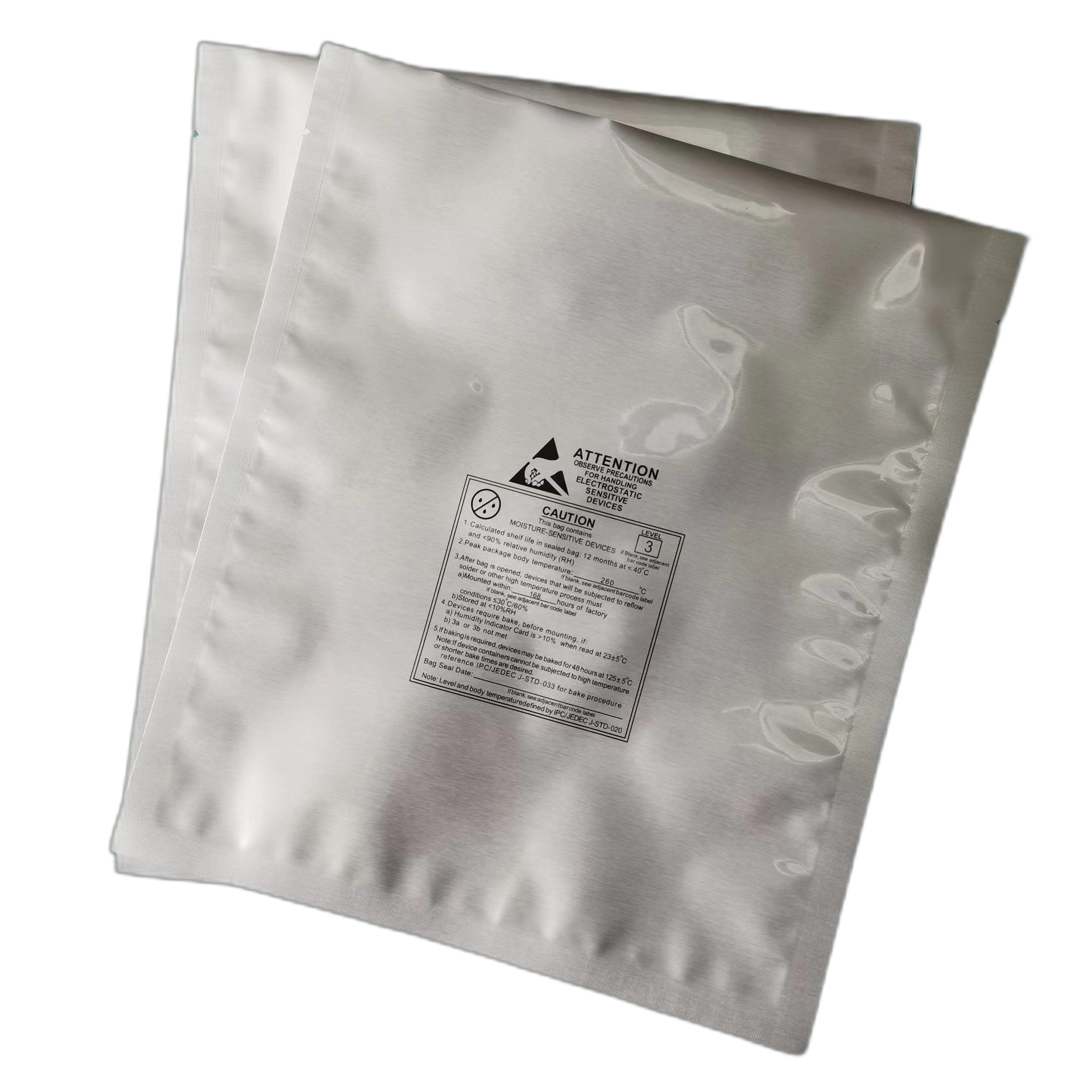FR1302 ESD Moisture Barrier Bag
Material: four layer compound structure
Surface resistance:10^9-10^11ohm
Feature: antistatic, moisture proof, anti-electronic components packing
Suitable for PCB,IC and other static sensitive components packing
Different sizes available
Products
Products DETAILS
FR1302 ESD Moisture Barrier Bag
ESD Moisture Barrier Bags (MBB) – In-Depth Guide
An ESD Moisture Barrier Bag (MBB) is a specialized packaging material designed to protect moisture-sensitive and electrostatic-sensitive devices (MSDs & ESDs). These bags provide dual-layer protection against electrostatic discharge (ESD) and moisture vapor that can cause oxidation, corrosion, or failure of sensitive components.
1. Understanding the Need for ESD Moisture Barrier Bags
Electronics, particularly Surface-Mount Devices (SMDs), ICs, PCBs, and BGAs, are highly susceptible to damage from:
Electrostatic Discharge (ESD) – Can destroy or weaken sensitive components.
Moisture Absorption – Can cause defects such as "popcorning" (moisture expanding and cracking a chip during soldering).
Oxidation & Corrosion – Moisture leads to oxidation, which degrades electrical connections.
Long-Term Storage Issues – Extended exposure to humidity can cause degradation of semiconductor properties.
To prevent these issues, Moisture Barrier Bags (MBBs) are used in conjunction with desiccants and humidity indicator cards (HICs) to maintain a dry, static-free environment.
2. How ESD Moisture Barrier Bags Work
MBBs rely on a multi-layer structure that provides both ESD shielding and moisture protection.
A. Multi-Layer Construction
-
Outer Layer: Polyester (PET) or Nylon
-
Provides durability and prevents bag punctures.
-
Antistatic coating prevents charge buildup.
-
-
Metallic Shielding Layer (Aluminum or Metalized Film)
-
Acts as a Faraday cage, blocking electrostatic fields.
-
Significantly reduces moisture vapor transmission rate (MVTR).
-
-
Polyethylene (PE) or Polypropylene Layer
-
Provides flexibility and an additional barrier against moisture.
-
Helps in heat-sealing for airtight closure.
-
B. How It Prevents Moisture Damage
-
MBBs have a low MVTR (Moisture Vapor Transmission Rate), meaning they greatly reduce the amount of moisture that passes through the bag over time.
-
When used with desiccants, moisture inside the bag is absorbed, keeping relative humidity (RH) below 10%.
-
Humidity Indicator Cards (HICs) change color if moisture levels rise, helping users assess bag integrity before opening.
3. Types of ESD Moisture Barrier Bags
A. Foil-Based Moisture Barrier Bags (Aluminum Foil MBB)
Best for: Long-term storage, high-sensitivity devices.
Features: Maximum moisture and ESD protection.
Structure: Includes a thick aluminum foil layer for optimal shielding.
Use Cases: Semiconductors, PCBs, aerospace components.
B. Transparent Metalized Moisture Barrier Bags
Best for: Visibility and moderate protection.
Features: Medium moisture resistance with ESD shielding.
Structure: Metalized polyester film instead of thick aluminum foil.
Use Cases: Short-term storage, components that require easy identification.
4. How to Properly Use an ESD Moisture Barrier Bag
A. Packing Process
-
Place the Component Inside the MBB
-
Ensure the item is free of contaminants.
-
-
Add Desiccants & Humidity Indicator Card (HIC)
-
Desiccants absorb residual moisture inside the bag.
-
HIC allows monitoring of moisture levels before opening.
-
-
Vacuum or Heat-Seal the Bag
-
Use a vacuum sealer or heat sealer to close the bag airtight.
-
This prevents air and moisture from re-entering.
-
-
Store in an ESD-Safe Environment
-
Keep the bags in a dry cabinet or ESD-safe storage area.
-
Avoid exposing to direct sunlight or high humidity.
-
5. Key Standards & Compliance for MBBs
Moisture Barrier Bags must meet industry regulations to ensure quality and effectiveness.
| Standard | Description |
|---|---|
| ANSI/ESD S541 | Ensures materials provide effective ESD protection. |
| MIL-PRF-81705 Type I & III | Military-grade barrier materials for ESD & moisture protection. |
| JEDEC J-STD-033D | Industry standard for handling and storage of moisture-sensitive devices. |
| IPC/JEDEC-STD-020 | Defines moisture sensitivity levels (MSL) for electronic components. |
Tip: If storing for long periods, make sure your MBB is MIL-PRF-81705 compliant for the best results.
6. Common Applications of ESD Moisture Barrier Bags
Semiconductors & Microprocessors – Highly sensitive to moisture damage.
PCBs & Circuit Boards – Protects against static and oxidation.
Aerospace & Defense Electronics – Long-term storage of high-value components.
Medical Devices – Ensures sterility and prevents degradation.
Automotive Electronics – Protects against humidity-related failures.
7. Choosing the Right ESD Moisture Barrier Bag
When selecting an MBB, consider:
Thickness: Thicker materials (e.g., 4.4 mil or higher) offer better protection.
Moisture Vapor Transmission Rate (MVTR): Lower MVTR values mean better moisture protection.
Size & Compatibility: Ensure the bag is large enough to accommodate your components.
Compliance Standards: Check for ANSI/ESD, JEDEC, and MIL-PRF ratings.








